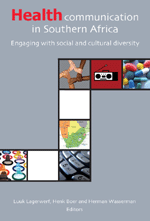Health Communication In Southern Africa: Engaging With Social And Cultural Diversity ~ Introduction
No Comments yet Introduction
Introduction
A focus on Southern Africa as an area where more and better HIV/AIDS communication is needed cannot be better underlined than by recent figures on adults living with HIV (15-49 years): In Sub-Saharan Africa the figure stands at 11%, whereas the global percentage is 3.25% (UNAIDS, 2008). The rise in these figures over recent years can partly be accounted for by the introduction of antiretroviral therapy, which means that statistically people living with HIV have a higher life expectancy.
Still, 67% of the global HIV prevalence in 2007 was accounted for by Sub-Saharan Africa, as was 72% of the global AIDS deaths (UNAIDS, 2008). The HIV/AIDS epidemic in Southern Africa affects women more than men (60% of people living with HIV were female in Southern Africa in 2007; UNAIDS, 2008), especially regarding HIV prevalence among youth. It is within this context that this book wants to consider the role that health communication may play in combating the HIV/AIDS epidemic.
Positive outcomes of health communication
How can health communication benefit the fight against HIV/AIDS? This positive influence may apply at different levels. Communication is an important part of prevention campaigns like in the case of the ABC (Abstinence, Be faithful, use Condoms) motto, which could contribute to a decline in HIV infections. Since the HIV/AIDS epidemic in Southern Africa typically affects women more adversely than men, gender relations form an important contextual dimension of health communication. Prevention messages have to be reinforced by the empowerment of women, enabling them to change their vulnerable position in sexual relations and negotiations.
Prevention and treatment go hand in hand and both aspects should be addressed in health communication. Voluntary Counselling and Testing (VCT) is a desirable outcome for several reasons. If people are infected they can get treatment and guidance. The spreading of infections may be controlled by more knowledgeable and responsible behaviour by HIV-infected people. Being more open about VCT might also change the perceptions of people living with HIV. Health communication can take the form of campaigns for better drug regimens and adequate state support. People living with HIV/AIDS (PLWA) need to take antiretroviral medicine to avoid AIDS, and their Antiretroviral Therapy (ART) compliance might be improved by good instruction and motivation. New media technologies have created opportunities to develop support networks for social movements and non-governmental organisations working to ensure better access to anti-retroviral medicines for PLWA.
The best-known example of such a network in Southern Africa is the one built around the group Treatment Action Campaign (Berger, 2006; Wasserman, 2005). The portrayal of PLWA may be changed in a more positive direction. Mass media and government policies need to be analyzed critically to detect and change negative or undesirable social representations of HIV/AIDS, or of individuals or groups associated with the disease. Health communication may serve to counter stereotyping, vilification or marginalisation of PLWA in sections of society who are seen as undeserving of state support, e.g. prisoners, migrants, asylum seekers, or sex workers (Berger, 2006).
Challenges in the Southern African context
There are however, barriers and problems when trying to achieve these effects. The challenges for health communication are numerous, and occur at different levels. Campaigns such as ABC, often driven by foreign donors and NGOs, need to be embedded within local social relations and need to be complemented by attempts to address power structures and material conditions if they are to be successful. Stigmatisation and AIDS-denial create obstacles for people to engage in VCT and comply to ART, and help spreading the epidemic. Critical media coverage may highlight problems and challenges hampering the fight against HIV/AIDS.
Politicolegal discourses around HIV/AIDS range from government denialism (until recently the case in South Africa) to laws criminalizing sexual relations between men which may lead to imprisonment without access to condoms (e.g. in Botswana; Berger, 2006), and the lack of state-supported programmes for access to anti-retrovirals.
In multilayered African societies, marked by linguistic, socio-economic, and cultural diversity, health communication messages have to take account of the possible different ways in which messages will be interpreted and understood within given contexts. ‘One-size-fits-all’ messages may not reach all of these groups adequately (Hoeken, Swanepoel, Saal, & Jansen, 2009).
Unlike in media-saturated Western societies, access to mass media and education remains unequal in Southern Africa. This creates an exposure problem, but also poses a cognition problem: if messages do come across, will these groups understand them the way they were intended? Despite the inequality and other socio-cultural limitations that may impede health communication, South Africa has pluralistic and diverse media, which may lead to mixed messages reaching audiences. Health information communicated on one media platform may be contradicted in another.
Material conditions impact on behavioural intentions. The difficult daily life circumstances may interfere with actual safe sex behaviour (for instance, poor women are more engaged in transactional sex; UNAIDS, 2008). Especially this latter barrier is difficult to overcome by means of health communication. Still, research and practice in health communication demonstrate some viable approaches to help fight the HV/AIDS epidemic.
Health communication approaches
Health communication research may assist in overcoming the practical challenges mentioned above. It is inevitable that a variety of approaches is needed at different levels. A recent overview of culturally adapted health communication message design is given in Swanepoel and Hoeken (2008).
Health communication approaches include research at the individual, community, and societal level. Individual psychological approaches, mass media campaigns, and group-based communal activities may go hand in hand and reinforce each other. We distinguish three active main approaches in current South African health communication research and practices: attitudinal and motivational antecedents to health behaviour; the effects of entertainment education and social representations of HIV/AIDS in mass media; and patient information in the context of social and cultural diversity. Although these approaches represent mainstream Western health communication research, it is the locus of the research that strongly changes the outcomes and applications. This will be demonstrated in a brief sketch of these approaches as they are represented in the first three parts of this book. in the Southern African context.
Individual and social network factors.
Currently, the most inflUential theory explaining the antecedents of individual intentions to healthy or responsible behaviour (ABC, VCT, or ART) is the Theory of Planned Behaviour, later developed into the Integrative Model of Behavioural Prediction (Fishbein & Yzer, 2003). In this model beliefs about consequences, normative issues, and efficacy with respect to a particular behaviour determine the intention towards that behaviour. In the southern African context we are faced with challenges regarding all three antecedents. Knowledge about the consequences of unsafe sex is poor in many rural areas and communities with inadequate education (Boer & Mashamba, 2005).
Subjective norms are dependent on prevailing societal norms, and stigmatisation of people having HIV/AIDS hampers VCT or ART (Kalichman & Simbayi, 2003). Efficacy of behaviour is especially problematic in situations where women do not have the power to demand safe sex behaviour, due to their economic position or to cultural influences.
Whereas the antecedents of intended behaviour may indicate specific problems or solutions for individuals, other factors may prevent behavioural intentions from turning into actual behaviour. People live in social environments which may determine their behaviour irrespective of their individual intentions. Social norms in a network may also determine individual subjective norms. It is therefore pivotal that social networks are studied to make normative innovations possible (Kincaid, 2004). Potentially influential groups or individuals may be identified. If a social network is unraveled, communication strategies may be tailored for individual interventions, mass media campaigns, or combinations of activities.
Social representations and entertainment education.
Mass media communication in South Africa is complex for several reasons. One would have expected that the press freedom brought about by the demise of apartheid would have allowed for a greater diversity of perspectives in the mass media, but elite perspectives still seem to dominate the mainstream media. The continued marginalisation of certain groups in the media may result in social representations of PLWA not achieving the desired social identification (Wasserman, 2006). If media users do not appreciate broadcasts as being about them, they will not be affected by a broadcast’s content. Or worse, broadcasts failing to address the right target groups risk to reinforce stereotypes instead of fighting them.
Another Southern African problem is the limited access to print and broadcast media. Whereas Western media markets are saturated with mass media supply, many societal groups do not have access to mass media information. Instead, they are dependent on interpersonal communication, which may keep them from obtaining correct knowledge on health issues. However, radio broadcasts are quite commonly received and make it possible to overcome infrastructural barriers. Radio may be instrumental to provide information to many groups effectively (Kenny, 2002). It is important however, to develop interesting and trustworthy programmes to attract attention and provide proper information.
Emerging market nations like in Southern Africa are undergoing a ‘leapfrog development’ in Information and Communication Technologies, enabling social movements to create activist networks and support groups through the internet (Wasserman, 2005). An interesting application in health communication is the development of text messaging onjcell phones.
In contrast to these negative effects on social representations, mass communication can be effective in providing health information. Non-Governmental Organisations (NGOs) like Soul City use television, radio, and print media to deliver health information in attractive and convincing ways (Goldstein, Perlman, & Smith, 2008). Using the attraction of personalisation, drama, and narration, entertainment education (or edutainment) might help to make people aware of the consequences of unsafe behaviour and the importance of VCT, or might reduce stigmatisation (Kincaid, 2002).
Patient information.
Much of the HIV/AIDS communication is delivered at an individual level. Leaflets and interpersonal communication account for most of the delivered patient information. Leaflets are often not designed within the local communities. The information might therefore not be understood, or followed within the local communities where it needs to be effective (Swanepoel, Burger, Loohuis, & Jansen, 2008).
Visual information is often considered superior to textual information in overcoming barriers of low education. However, visual literacy is needed to properly understand visual instructions (Avgerinou & Ericson, 1997). Low-literate individuals miss exposure to visual messages to the same extent as textual information. Providing explanatory context might help improve understanding (Phillips, 2000). In order to identify cultural and cognitive problems with understanding patient information, the information needs to be tested within the relevant target groups. Interpersonal communication in patient information might overcome these kinds of barriers.
Overview of contributions
The contributions in this book are divided into four parts. The first three parts represent research done in one of the approaches we distinguished in health communication: individual and social network factors, social representation and entertainment-education, and patient information. The fourth part consists of three campaign examples that have been effectively implemented along the lines of the three aforementioned approaches.
Individual and social network factors.
The Theory of Planned Behaviour is involved in research among larger groups of individuals, in order to determine antecedents of behavioural intentions. Mass communication campaign designers may learn from research outcomes to set their goals. It is important to verify whether there are differences between groups in different societies. Merel Groenenboom, Julia van Weert, and Bas van der Putte present a survey among Tanzanian and Zambian residents to identify differences in their antecedents to condom use intentions.
External to the Theory of Planned Behaviour is the social network approach. Determining the patterns of social linking between groups in local communities provides information on communication strategies that might overcome barriers posited by the social environment. Rachel Smith presents and analyzes social network data of ten rural Namibian communities, and formulates strategic consequences.
The power of social networks is that they may change social norms by means of communication between members of the network. However, topics like HIV/AIDS or sexual behaviour are often taboo or stigmatised, making interpersonal communication between peers or primary group members difficult. Henk Boer and Tessa Custers analyze how communication on these topics is realised among young adolescents in a South African Township. Social capital determines in part interpersonal communication on sexual and health topics. Improving an individual’s social capital might therefore lead to a change in social norms and attitudes on healthy behaviour.
Social representations and entertainment education.
In mass communication media, there is a mutual influence between target groups and the media they use. Cecilia Strand analyzes how local print media portray HIV/AIDS. Media might disturb media users’ perceptions by constantly reporting on certain aspects of an issue. When news about the disease is focusing on its unavoidability and ubiquity, government policies or health communication may be less effective. John-Eudes Lengwe Kunda and Keyan Tomaselli analyze different discourses on HIV/AIDS, and reveal social representations of the disease. Health messages in South Africa and Zambia do not always adapt to audiences’ myths and assumptions with respect to HIV/AIDS. By connecting messages to existing discourses health communication may be more successful in changing attitudes or perceptions. The South African Broadcasting Corporation has undergone different postapartheid transitions. Besides transforming into a more diverse broadcasting company, the SABC had to supplement support from the state with advertising income, which led to a more commercial management even as it was subjected to increasing allegations of political interference in its editorial content. Viola Milton studies the consequences of these transitions for the impact of the edutainment programmes SABC is programming.
In many Southern African countries, radio has the broadest reach of all mass media. This does not say anything about programme effectiveness. Radio listeners tend to ignore information they consider to be meant for others. Radio journalists do not always have the proper skills and means to enhance the effectiveness of health communication in their programmes. Mia Malan describes how journalists in a training programme discovered ways to make responsive and appealing radio broadcasts, by personalizing the health information.
Patient information.
Visual aids to provide health information to patients can be helpful to inform low-literate patients, but the design of pictograms needs to be designed for the communities in which it is provided. Ros Dowse reports on her research into the effectiveness of pictograms with low-literate HIV/AIDS patients in South Africa.
Low education does not only hinder textual understanding, it creates problems for the comprehension of visual information as well. Hanneke Hoogwegt, Alfons Maes, and Carel van Wijk show the difficulties of interpreting visualised motion in health communication instructions.
An important condition for ART compliance is a proper understanding of the medicine’s dosage instructions. Interpersonal communication is often difficult in a multilingual situation. In a pharmacy setting, Jennifer Watermeyer and Claire Penn analyze how patient information may be enhanced by using props in medicine dosage instructions.
In general, medicines are manufactured in the Western world. Pharmaceutical industry’s patient information in South Africa is not well adjusted to specific South African contexts. As a result, patient information leaflets are not always fine-tuned to the situations of different patient groups living in South Africa. Daleen Krige and Johann De Wet investigate how these leaflets may be improved for South African society.
Supporting people: Approaches to HIV/AIDS communication activities.
Hugo Tempelman and Adri Vermeer are involved with a comprehensive and integrative health communication campaign in the South African Elandshoorn region. Following the Theory of Planned Behaviour, they establish the factors that determined who actually went for VCT, and who didn’t.
The DramAidE Health Promotor project is a large and comprehensive campaign at many South African Universities. Based on entertainment education, and on principles of peer influence, HIV positive Health promoters are engaged in organising health communication activities, assisting peer educators, and advising students. Emma Durden gives an overview of the project evaluations over time on several locations.
Patient information has to overcome cultural and educational barriers, but the barriers of infrastructure are ubiquitous in South Africa. The diffusion of cell phones in the South African society, however, is rapidly growing. Tanja Bosch describes how patient information can be timely delivered to improve ART compliance.
Conclusion
The Southern African HIV/AIDS epidemic presents challenges for health communication at different levels: at the individual, social and cultural level. Recognition and understanding of these different levels is necessary to optimise the role that health communication can play in combating the epidemic. Contributions from different disciplines present innovative health communication research, while some chapters report on actual, comprehensive, and effective campaigns for prevention and support. We therefore hope that this book will be of use for both researchers and practitioners in health communication.
Acknowledgements
The authors want to thank SAVUSA, especially Saskia Stehouwer and Harry Wels, for putting a lot of dedication and effort into the realisation of this book. The initiative for this book was taken in a health communication session at the 2008 Communication Science Conference for Dutch, Flemish, and South African researchers (‘Etmaal van de Communicatiewetenschap 2008, VU University Amsterdam’).
References
Avgerinou, M., & Ericson, J. (1997). A review of the concept of visual literacy. British Journalof Educational Technology, 28(4), 280-291.
Berger, J. (2006). A is for arrogant, B is for brazen. Treatment action campaign website. Retrieved 27 February, 2009 from http://www.tac.org.za/community/node/2219.
Boer, H., & Mashamba, M.T. (2005). Psychosocial correlates of HIV protection motivation among black adolescents in Venda, South Africa. AIDS Education and Prevention, 17(6), 590-602.
Fishbein, M., & Yzer, M.C. (2003). Using theory to design effective health behavior interventions. Communication Theory, 13, 164-183.
Goldstein, S., Perlman, H., & Smith, C.J. (2008). Health education in action in Southern Africa: Soul City. In P. Swanepoel, & H. Hoeken (Eds.), Adapting health communication to cultural needs. Amsterdam: John Benjamins.
Hoeken, H., Swanepoel, P., Saal, E., & Jansen, C. (2009). Using message form to stimulate conversations. The case of tropes. Communication Theory, 19(1), 49-65.
Kalichman, S.C., & Simbayi, L.C. (2003). HIV testing attitudes, AIDS stigma and voluntary HIV counselling and testing in a black township in Cape Town, South Africa. Sexually Transmitted Infections, 79, 442-447.
Kenny, C. (2002). Information and communication technologies for direct poverty alleviation: Costs and benefits. Development Policy Review, 20(2), 141-157.
Kincaid, D.L. (2002). Drama, emotion, and cultural convergence. Communication Theory, 12(2), 136-152.
Kincaid, D.L. (2004). From innovation to social norm: Bounded normative influence. Journal of Health Communication, 9(Supplement 1, June), 37-57.
Phillips, B.J. (2000). The impact of verbal anchoring on consumer response to image ads. Journal of Advertising, 29(1), 15-25.
Swanepoel, P., Burger, M., Loohuis, A., & Jansen, C. (2008). Promoting VCT among South African students: Are we missing the message? In P. Swanepoel, & H. Hoeken (Eds.),Adapting health communication to cultural needs (pp. 89-106). Amsterdam: John Benjamins.
Swanepoel, P., & Hoeken, H. (Eds.). (2008). Adapting health communication to cultural needs. Amsterdam: John Benjamins.
UNAIDS. (2008). 2008 Report on the global AIDS epidemic. Geneva: Joint United Nations Program on HIV/AIDS.
Wasserman, H.J. (2005). Renaissance and resistance: Using ICTs for social change in Africa. African Studies, 64(2), 177-199.
Wasserman, H.J. (2006). Globalized values and postcolonial responses. South African perspectives on normative media ethics. International Communication Gazette, 68(1), 71-91.
You May Also Like
Comments
Leave a Reply





